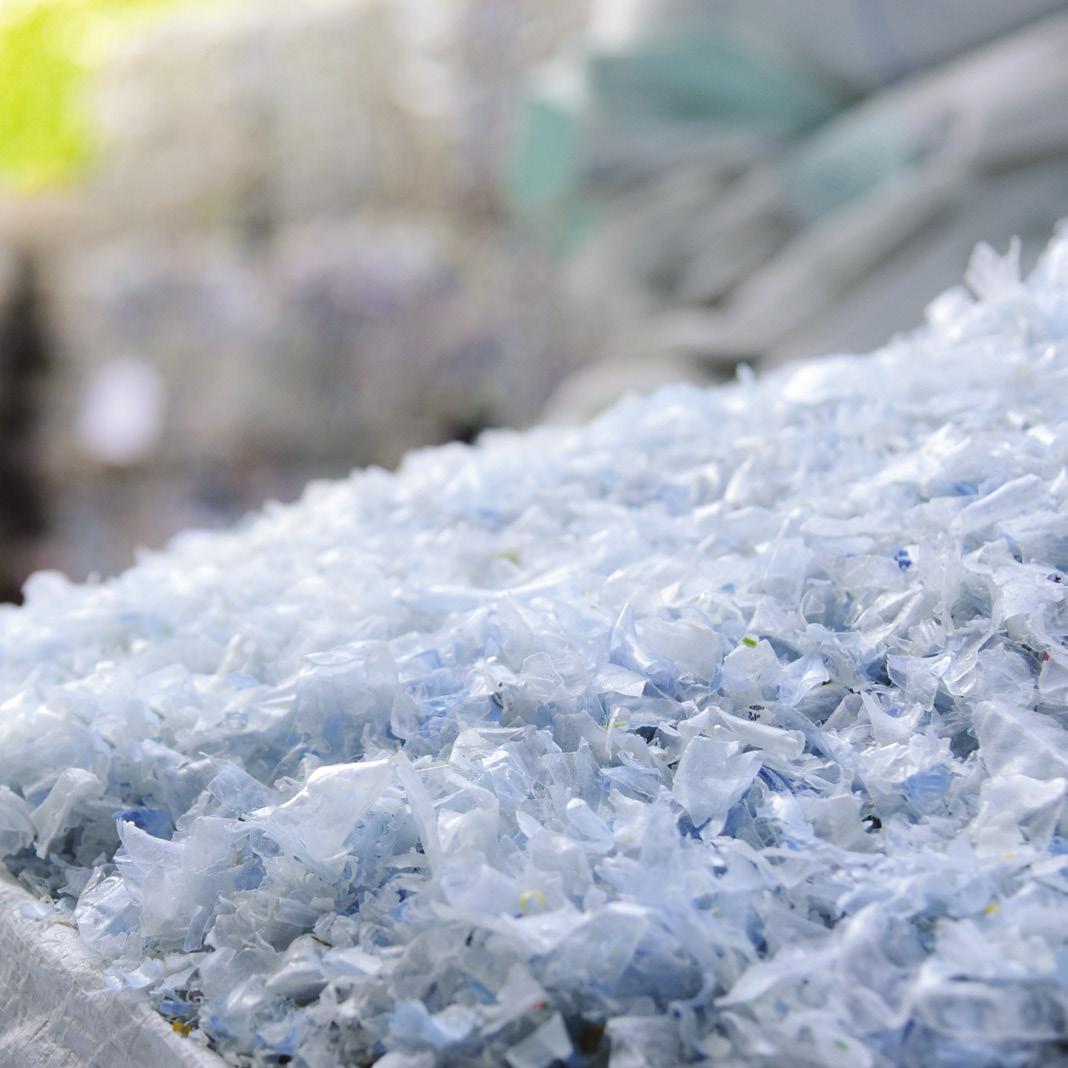
7 minute read
Building on the plastics tax
from Fixing the system
In the 2018 budget, the chancellor promised to introduce a “world leading” tax on plastic packaging. 125 In combination with other measures on plastics set out in the resources and waste strategy, and various voluntary agreements from businesses, this has led to an increase in investment in plastic recycling facilities in the UK. 126
This shows how fiscal measures can influence developments. In this section, we examine how the plastics tax should be adjusted to align better with the government’s ambitions, and what other financial incentives could be employed to improve wider resource use.
Advertisement
Essential fixes
The government’s proposed tax on packaging that has less than 30 per cent recycled content seeks to redress market balances that have disadvantaged recycled content. Draft legislation is expected this year, and it is likely to come into force by 2022.
Before it does, it needs two essential fixes:
Include imported filled packaging. An exclusion for filled packaging would encourage multinationals with access to global supply chains to shift production of both packaging and products abroad. This could damage the UK economy.
Introduce differentiated obligations. Recycled content is easier to achieve for some polymers than others. A single obligation will encourage gaming and switching between polymers. For example, manufacturers could reduce recycled content in packaging already exceeding the threshold so they can increase it elsewhere, resulting in no overall increase.
Increasing ambition
The following actions would encourage innovation in the plastic recycling sector and improve the effectiveness of the tax in driving recycled content:
Introduce an escalator: The 30 per cent recycled content target is unlikely to drastically increase ambition, as the UK Plastics Pact is already targeting an average of 30 per cent recycled content across all plastic packaging by 2025. 127
Ramping up ambition could be achieved through an escalator, like that used effectively for landfill. The escalation could be on the rate of tax, the percentage of recycled content needed to avoid the tax, or both. UK businesses would benefit from a long term trajectory to help domestic supply chains increase recycled content and avoid being locked in to foreign supply chains. This would also encourage technology developers to overcome barriers to higher recycled content use.
Introduce a stabilisation fund: The relative effectiveness of a flat tax is likely to change according to market conditions. These include seasonal variations for plastic prices and fluctuations in oil prices. 128,129
Analysis by McKinsey suggests that below $65 per barrel of oil “the economics of mechanical recycling become more challenging” and chemical recycling might become unprofitable below $50 a barrel. 130 It is difficult to predict what future prices will be. The central assumption made by the Department of Business, Energy and Industrial Strategy (BEIS) for the years 2030-35 is $78 a barrel. But its stress test of $35 a barrel could be more realistic, given global moves to stop burning fossil fuels, combined with a glut of cheap shale gas. 131
A price stabilising mechanism could derisk investments in reprocessing and ensure that recycled content, as the more sustainable option, is always cheaper than virgin material. The fund would absorb money when recyclate prices exceed an upper threshold and release money when prices fall. Potential sources of funding for this idea include reprocessors, producers, the extended producer responsibility (EPR) system, unclaimed DRS deposits or revenue from the plastics tax. Ensuring that income closely matches outlay will be essential.
Introduce contracts for difference: A more interventionist approach would be to introduce contracts for difference (CfDs) for recycled content, modelled on the system used in the renewable energy sector.
Translating this to plastics could increase the speed at which new recycling technologies come online, while also enabling supply chain investment that would reduce the final cost of reprocessed material. Reprocessors would be awarded contracts based on an auction. They would be paid the difference between the ‘strike price’, which would reflect the cost of investing in a recycling technology and generating recycled material, and the ‘reference price’, a measure of the average market price for plastic in the UK, which would vary by polymer type. Funding could come from the same sources as the stabiliser described above.
Contracts for difference (CfDs) for renewable energy are funded by a compulsory levy on all licensed energy suppliers in the UK, based on their market share. Renewable energy generators are awarded 15 contracts at auction with the Low Carbon Contracts Company (LCCC), an independent, government owned company. 132 Renewable energy generators are paid the difference between the ‘strike price’, a price for electricity reflecting the cost of investing in a particular technology, and the ‘reference price’, a measure of the average market price for electricity in the UK. 133 When the market price exceeds the strike price, generators pay back the difference. This competitive approach has encouraged innovation and has reduced the cost of clean energy. Renewables are now the cheapest form of new energy in the UK. 134
How the CfD system works for renewable generators 135
100
80 60 40 20 0 Electricity price £/MWh
-20
-40 Generator topped up to strike price Strike price
Market revenue £/MWh CfD payment £/MWh Monthly electricity price Time Generator pays back
“Virgin material taxes should be on the government’s net zero agenda.” Radical option: virgin material taxes
Regardless of any adjustments, the plastics tax, as currently envisaged, will only drive recycled content in plastic packaging, which is a small proportion of material use in the economy.
Fiscal measures could be used much more ambitiously to drive the better use of resources, moving beyond plastic, beyond packaging and beyond recycling to target lower material use.
Virgin material taxes should be on the government’s net zero agenda. These have already been used widely across Europe, though predominantly for sand, gravel and rock extraction. And there is already a precedent in the UK. Introduced in 2002, the aggregates levy is one of the most effective material taxes in Europe. It involves a tax of £2 per tonne on domestic and imported aggregate and has driven recycled content above 30 per cent in the UK, compared to around ten per cent in countries in the EU.
This type of national taxation is most suited for metals and minerals extracted and traded at the local level, but is more complicated for global trading. 136 An approach is needed that taxes virgin materials to reflect their global impacts. Given the strong link between resource use and climate change, it might make sense to use carbon as the proxy. In the UK, for instance, the 30 economic sectors (out of 106 categories) that account for 80 per cent of the total carbon footprint, also account for 80 per cent of the total material footprint. 137
With the UK due to host the next UN climate talks in November 2020, it has the perfect opportunity to lead global discussions on introducing this approach to encourage greater resource efficiency across the world.
The aggregates levy has increased recycled content 138
300 35
Thousands of tonnes Percentage 100 150 200 250
10 15 20 25 30 1995 1997 1999 2001 2003 2005 2007 2009 2011 2013 2015 2017 Calendar year
Recycled and secondary aggregates Primary aggregates Proportion of aggregate from recycled or secondary sources
Innovative fiscal arrangements can be used by private companies as well, in the absence of government action or to complement regulation.
Casella Waste Systems, for instance, operates in the north east United States, in a market where many refuse collectors operate recycling services as a loss leader for other services. The company wanted to develop a business model to make recycling more financially sustainable. Initially, it attempted to broker long term contracts for recycling collections to fix future income in the face of volatile markets. However, this arrangement only proved successful for high value aluminium, meaning further investment in paper and plastics recycling was difficult to justify.
Instead, the company developed a variable pricing mechanism whereby its customers are charged a ‘sustainability recycling adjustment fee’ based on the monthly market prices for recycled commodities and fixed costs, including transportation. Through this mechanism, the company passes on 90-93 per cent of risk to the consumer, though the fee only varies between four and 15 per cent of the customers’ bills. (The 15 per cent peak was reached when commodity prices crashed at the time China, which had previously accepted much of the world’s recycling, stopped accepting shipments in 2018.) Initially, the added charge made the company less competitive than its rivals when bidding for contracts, but it has since become standard for larger recycling companies in the area. Customers have been receptive, as similar approaches have been adopted by airlines, via fuel surcharges on tickets, contributing to a growing awareness of the need to share out risks to deliver sustainable services.








